75 facts about Vancouver’s trolleybus system for each year of service

On August 16, 2023, we celebrate the 75th anniversary of the launch of the trolleybus system back in 1948 — three quarters of a century ago!
To commemorate this milestone, we’ve taken a trip down memory lane for 75 facts you might not know about the trolleybus system in our region.
Let’s go!
1. BC Electric first tested a 1940 Fageol Twin Coach electric trolley from Seattle for 10 days in December 1945 as a free demonstration and to gauge public opinion.
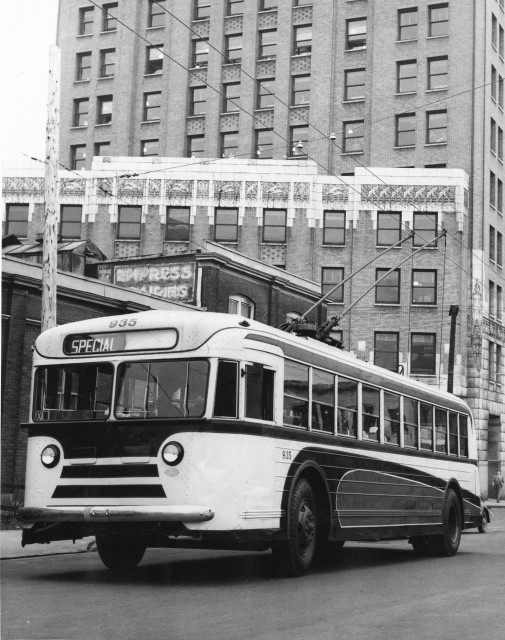
2. Trolley buses first arrived as part of the ambitious “rails-to-rubber” conversion to decommission the streetcar network.
3. Trolley buses pre-date diesel buses in Vancouver because diesel buses were initially considered not “ready for prime time.”
4. The first trolleybus order consisted of 30 Brill T-44s, each with a capacity of 44 passengers.
5. The Brill T-44 featured a 140-horsepower motor running under 550 volts of DC power.
6. The Brill T-44 weighs 18,510 pounds, about the weight of an African elephant.
7. Each T-44 cost $22,000 in 1949.
8. The prototype of the new E901 trolleys arrived, painted in the orange-and-white colours of the Urban Transit Authority (UTA) on April 2, 1982. But before the paint had dried, in August, the Province changed the name of the UTA to BC Transit, resulting in another paint scheme, this time red, white, and blue.
9. Bus operators who drove Brill buses often joked about having “Brill knee” — a nod to the heavy pedals, requiring a strenuous push when pressing.
10. The Brill buses were popular among mechanics with many preferring to eat their lunch and have coffee breaks inside a Brill bus instead of their designated cafeteria.
11. The first trolleybus route was the Fraser–Cambie, travelling along Fraser Street from Marine Drive to Kingsway, then down Main Street to Pender Street in Chinatown, left on Pender Street to Seymour Street, then to Robson Street and Cambie Street and over the Cambie Bridge to 29th Avenue.

12. That first route was 17 kilometres long and cost $31,853 per kilometre to build in 1948.
13. In 1949, a fire at Regina Transit destroyed its car barn with most of their system’s streetcars and new trolley buses. BC Electric (the operator at the time) offered its last order of two Brill T-44s, which were en route to Vancouver, to help their struggling system.
14. Trolleybus routes did not have route numbers until the early 1950s. Instead, only the destination was indicated on the front of the bus.
15. In 1954, Vancouver became the largest trolleybus system in Canada with 327 Brills in the fleet.
16. The last streetcar route to be in service was the #14 Hastings East route. Trolley buses were replaced beginning in June 1955. This route was renumbered in 1997 before we brought it back in 2015.

17. The trolleybus fleet was at its largest ever in 1957, with a purchase of 25 used Pullman 44-AS, totalling 352 buses in the fleet.
18. These Pullman 44-AS buses were purchased from Birmingham, Alabama’s transit fleet.
19. The Pullman 44-AS lasted just three years on our system, retiring in 1960.
20. There were plans to phase out the trolley bus in the late 1960s, but a global fuel crisis hit in the 1970s. This renewed the need for trolley buses and more of them.
21. BC Hydro (yes, the power company!) operated the trolleybus system from August 1961 until 1980.
22. Trolley buses didn’t have license plates until 1974! That’s because before then, they were classified as railway vehicles.
23. Hess, a Swiss manufacturer, demonstrated one of its articulated trolley buses in 1974, but it was never ordered. One of the reasons was its electromagnets interfered with television signals!
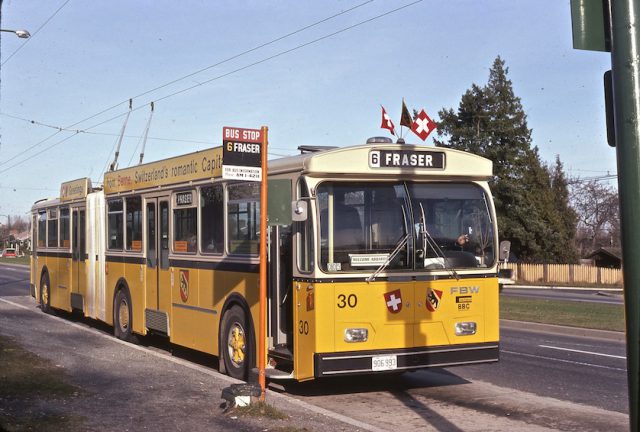
24. Trolley buses historically did not have auxiliary power onboard. In fact, when an overhead wire was without power, people would push the bus together to get the power flowing through the bus!
25. Older generations of trolley buses had no right-side mirrors — operators would ask passengers to their right if they were clear to move.
26. The Flyer E901, introduced in 1982, was the first trolleybus model to have regenerative braking to send power back to the overhead lines.

27. The first extension of the trolley bus outside of Vancouver was towards Burnaby in 1986, extending the original #19 route towards Metrotown. This was built to support the new SkyTrain stations and improve connectivity.
28. From 1988–1989, several out-of-service Flyer E800 trolley buses were converted to diesel buses, earning them the “triesel” name.
29. Until 1991, Vancouver was the only city in North America to have five parallel power lines over one street. This was on Hastings Street by the Pacific National Exhibition.
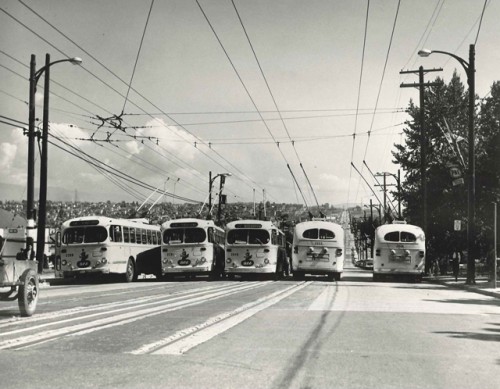
30. Rectifier stations, which power our trolley buses, used mercury arc rectifiers until 1993. Today, 22 rectifier stations throughout Metro Vancouver power our trolley fleet.
31. The last express trolleybus route to run was the #34 (and later renumbered to the #10) Hastings Express route, ending in 1997.
32. The trolleybus fleet has had five main operators over its history in Metro Vancouver: BC Electric Railway, BC Hydro, Urban Transit Authority, BC Transit, and finally, through TransLink, the current Coast Mountain Bus Company since 1999!
33. The only private operator of the trolleybus system was BC Electric Railway. It later became government-owned with BC Hydro and continues to operate as such.
34. Trolley buses have made some cameos on TV with appearances on the X-Files and Viper to name a few!
35. Our trolley buses have also been movie stars! Spotted in movies such as Rumble in the Bronx, Mother’s Justice, and Saving Silverman.
36. Trolley buses were historically all high-floor models (you had to take a few steps up to get on), until our current generation of trolleybuses’ introduction in 2005.
37. Trolley buses originally were maintained at the now-closed Oakridge Transit Centre at West 41st Avenue and Oak Street.
38. Until September 2006, Oakridge Transit Centre served as the base for all trolley buses for 58 years.
39. The entire trolleybus fleet is now located at the Vancouver Transit Centre, the only facility made to support this type of bus. The transit centre is currently home to 405 total buses (trolley, diesel, and hybrid!).
40. In 2007, we received our first articulated, 60-foot trolley bus. We now have 74 in our fleet.
41. Trolley buses are known for their longevity – the most recent generation of retired trolley buses were in operation from 1982 until 2008, that’s an impressive 26 years!
42. Four of the historic trolleybus fleet are still preserved today by the Transit Museum Society. These include a 1947 Canadian Car Brill T-44, a 1954 Canadian Car Brill T-84A, a converted-to-diesel 1976 Flyer E800, and a 1983 Flyer E902.
43. The conversion to low-floor trolley buses was completed in 2009.
44. Our trolleybus fleet today is built by New Flyer.
45. Throughout the years, all our trolley buses have originated from North American manufacturers: Canadian Car and Foundry, Pullman, and New Flyer!
46. Two trolley bus models are currently in operation today from New Flyer, the E40LFR and E60LFR. We’re the launch customer to launch all these models!
47. Our current trolleybus fleet uses motors made by Kiepe Electric!
48. The current generation of trolley buses have an emergency power unit that allows them to travel about a kilometre on flat ground without a trolley wire connection.
49. We’re the last trolleybus system in Canada. The most recent one to shut down was Edmonton’s system in 2009.
50. Before Edmonton’s trolleybus system shut down in 2009, we loaned them one of our trolley buses, #2242, for almost a year.
51. That same bus also made a brief visit to Seattle in December 2010 to demonstrate a new trolley technology. Talk about well-travelled!
52. If you visited Mendoza, Argentina between May 2009 and May 2017 you may have encountered one of our retired trolley buses, given a second life when they were sold to their local transit system.
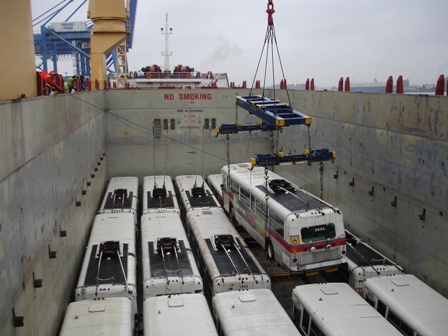
53. According to our estimates in 2018, trolley buses cost about $15,000 to power. On a diesel equivalent, that rises to about $40,000
54. Our newest trolleybus route is actually an old one! Trolley buses returned to the 41 Joyce Stn / Crown route in June 2020 after nearly a 20-year hiatus.
55. BC Electric acquired a former army barracks at 41st Avenue and Cambie Street as a temporary bus depot for the new gas and trolley coaches. Dubbed Little Mountain Garage it was used until the new $1.75 million Oakridge Transit Centre a few blocks away was built.
56. Some of the Brills had more than a million miles (1,609,300 kms) on them when they went out of service in 1982-1984
57. In its 75 years of history, Metro Vancouver trolley buses have changed their livery seven times.
58. We have one of the largest trolleybus fleets in North America! We have 262 trolley buses in our fleet, 74 of which are articulated.
59. We’re currently planning to procure a new generation of new trolley buses with in-motion technology, meaning they would be able to go off-wire for longer distances!
60. Trolley buses have shoes too! Not the shoes that we wear but contact shoes — these are contacts at the end of the poles and are designed to collect power from the overhead wires.
61. A typical overhead trolley line can weigh up to 1.4 tonnes!
62. Our trolleybus system has about 320 kilometres of trolley lines.
63. Currently, thirteen bus routes primarily operate using trolley buses.
64. The busiest trolleybus route in 2022 was the 16 29th Avenue Stn/Arbutus, with 4,627,000 total boardings.
65. Trolley buses run on a separate power system than we use in our daily lives. There are 22 rectifier power supply stations across Vancouver and Burnaby to power the trolley buses.
66. During the colder months, we use a unique de-icing truck that coats the overhead wires with a special solution to ensure they don’t freeze while in service.
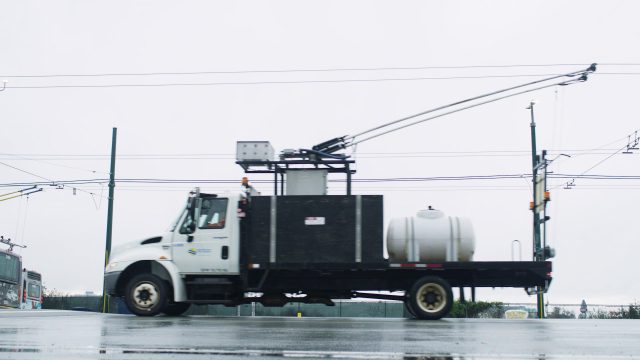
67. The de-icing compound we use on the overhead wires can prevent freezing for up to three days.
68. During the winter months select trolley bus contact shoes are switched from carbon to brass to “cut through” ice that can build up on the wires.
69. All trolley buses in Metro Vancouver have fleet numbers starting with a 2 followed by three more digits.
70. Riding a trolley bus is a great option for the environment — compared to driving a gasoline car, you reduce your carbon emissions by over 99 per cent!
71. Apart from Vancouver, Dayton, Guadalajara, Mexico City, Philadelphia, San Francisco, and Seattle, there are no other remaining trolleybus operators in North America today.
72. The latest system to retire trolley buses was Greater Boston’s Massachusetts Bay Transportation Authority (MBTA), when their Silver Line converted to fully diesel-hybrid buses in July 2023.
73. There are many synonyms for “trolley buses”. For example, MBTA’s trolley buses were identified as “trackless trolleys.” Other names include “trackless trams” and “trolley coaches”.
74. Trolley buses are known for their amazing hill-climbing abilities! In fact, San Francisco’s route 24 climbs a grade of 22.8% — the steepest known grade on a trolley bus!
75. Ever wondered why trolley buses have two poles instead of one? Since the rubber tires are non-conductive, one pole acts as a ground, while the other provides power.
![]()
With files from “Vancouver’s trolley buses, 1948-1998: celebrating a half-century of service” and thanks to employees from Coast Mountain Bus Company for contributing facts.






In Philadelphia we call them trackless trolleys as well. Only 3 routes remain primarily in the Northeast section of the city
@Super Mario Honestly, I don’t think rail trams still exist anywhere because of the complexity and inconvenience that their rail system brings.
Was born in Kitchener, Out., moved to Vancouver in 1965. Kitchener trolleys were shipped via train to Vancouver in 1973, Brill’s, I believe, when Kitchener ended it’s trolley system and were purchased by BC Hydro.